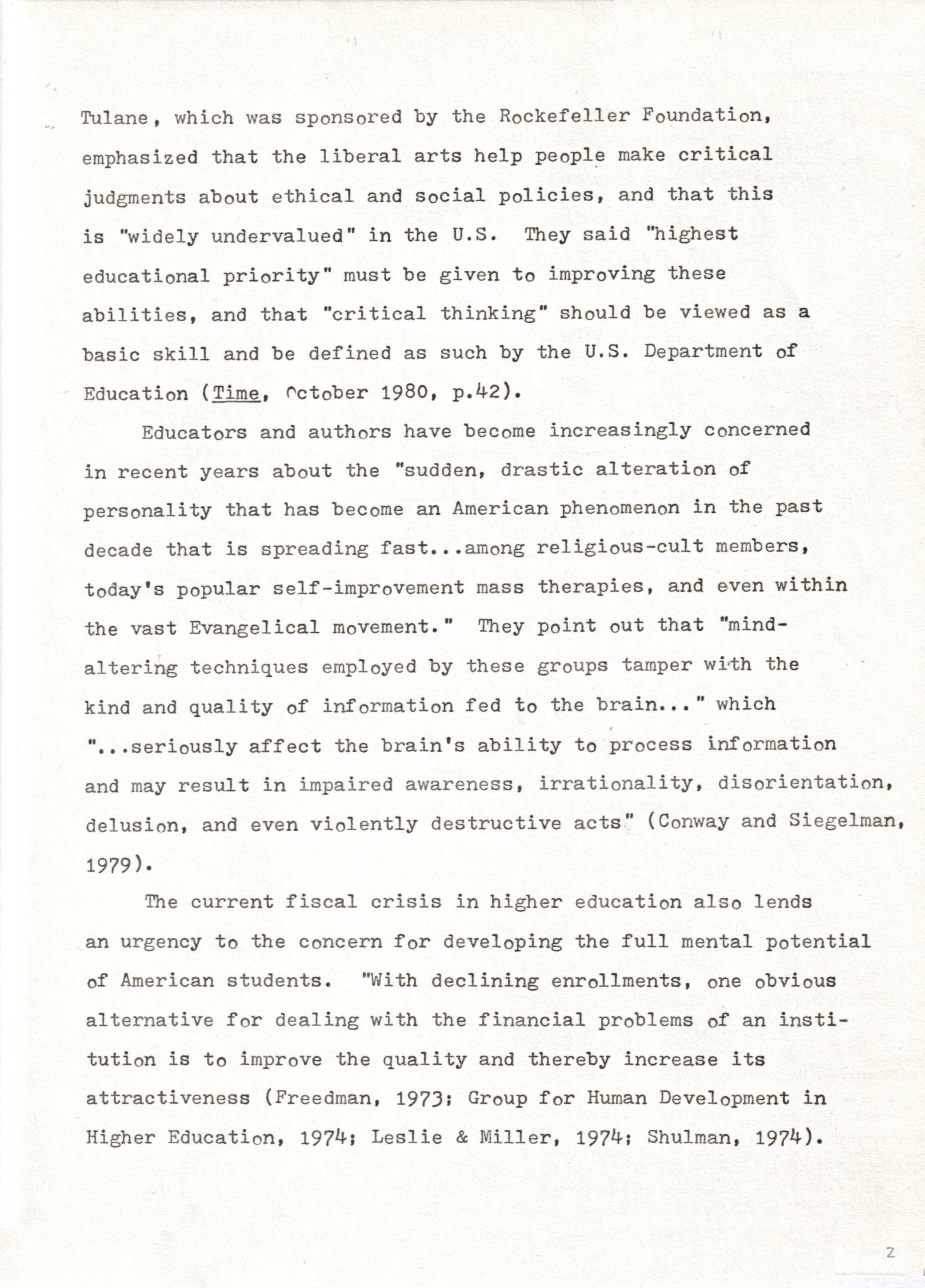
ctomeegmiu02.jpg
|
Tulane, which was sponsored by the
Rockefeller Foundation, emphasized that the liberal arts help people make
critical judgments about ethical and social policies, and that this is "widely
undervalued" in the U.S. They said "highest educational priority" must be
given to improving these abilities, and that "critical thinking" should be
viewed as a basic skill and be defined as such by the U.S. Department of
Education (Time, October 1980, p.42).
Educators and authors
have become increasingly concerned in recent years about the "sudden, drastic
alteration of personality that has become an American phenomenon in the past
decade thread is spreading fast...among religious-cult members, today's popular
self-improvement mass therapies, and even within the vast Evangelical movement."
They point out the "mind altering techniques employed by these groups tamper
with the kind and quality of information fed to the brain..." which "seriously
affect the brain's ability to process information and may result in impaired
awareness, irrationality, disorientation, delusion, and even violently
destructive acts" (Conway and Siegelman, 1979).
The current fiscal
crisis in higher education also lends an urgency to the concern for developing
the full mental potential of American students. "With declining
enrolments, one obvious alternative for dealing with the financial problems of
an institution is to improve the quality and thereby increase its attractiveness
(Freedman, 1973: Group for Human Development in Higher Education, 1974; Leslie &
Miller, 1974, Shulman, 1974). |
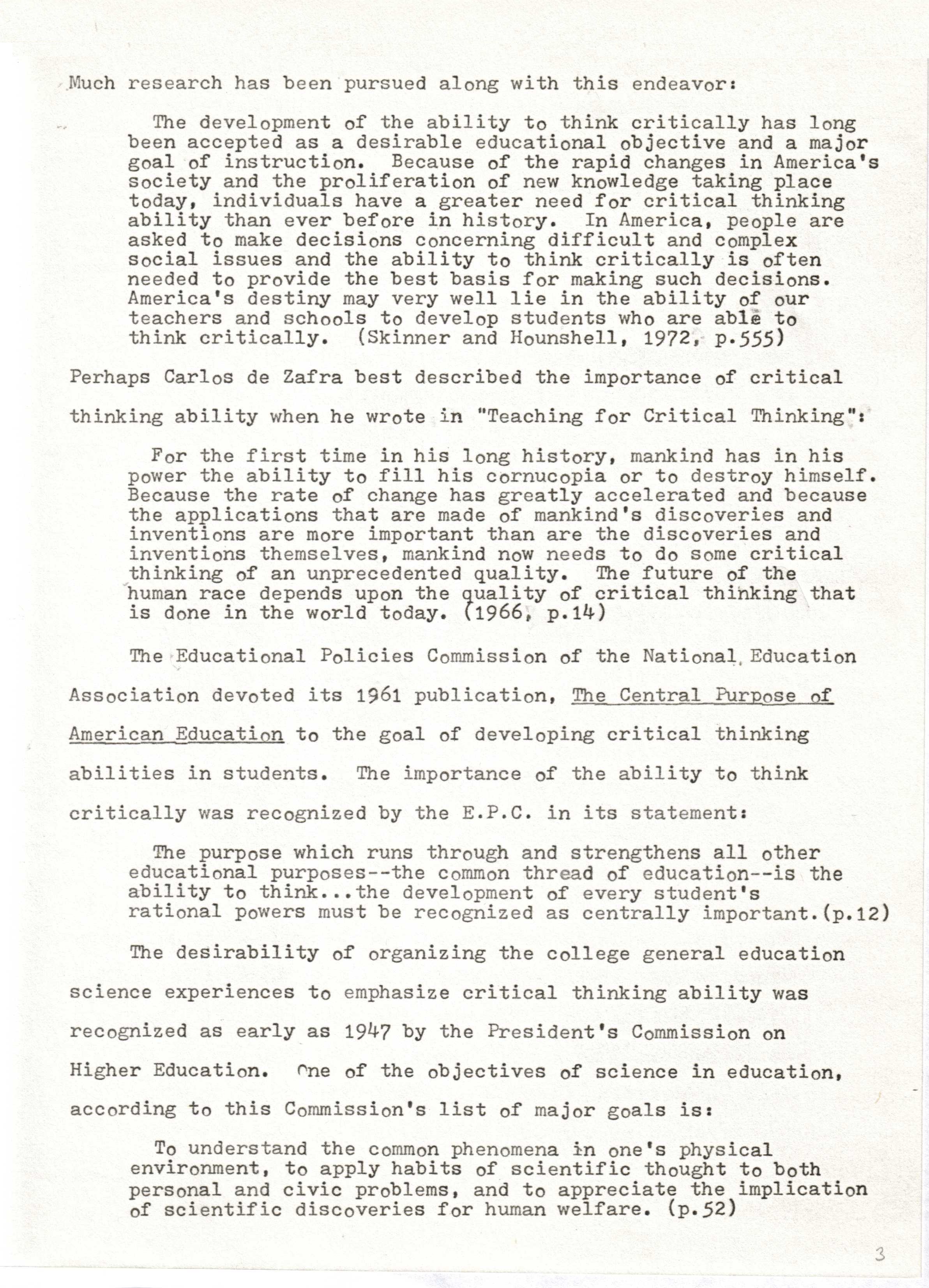
ctomeegmiu03.jpg
|
Much research has been pursued along with this endeavor:
-
The development of the ability to think critically has long
been accepted as a desirable educational objective and a major goal of
instruction. Because of the rapid changes in America's society and the
proliferation of new knowledge taking place today, individuals have a
greater need for critical thinking ability than ever before in history.
In America, people are asked to make decisions concerning difficult and
complex social issues and the ability to think critically is often needed to
provide the best basis for making such decisions. America's destiny
may very well lie in the ability of our teachers and schools to develop
students who are able to think critically. (Skinner and Hounshell,
1972, p.555)
Perhaps Carlos de Zaftra best
described the importance of critical thinking ability when he wrote in "Teaching
for Critical Thinking":
-
For the first time in his long history, mankind has in his
power the ability to fill his cornucopia or to destroy himself. Because
the rate of change has greatly accelerated and because the applications that
are made of mankind's discoveries and inventions are more important than are
the discoveries and inventions themselves, mankind now needs to do some
critical thinking of an unprecedented quality. The future of the human
race depends upon the quality of critical thinking that is done in the world
today. (1966, p.14)
The Educational
Policies Commission of the National Education Association devoted its 1961
publication, The Central Purpose of American Education to the goal of
developing critical thinking abilities in students. The importance of the
ability to think critically was recognized by the E.P.C. in its statement:
-
The purpose which runs through and strengthens all other
educational purpose--the common thread of education--is the ability to
think...the development of every student's rational powers must be recognized
as centrally important. (p.12)
The desirability of
organizing the college general education science experiences to emphasize
critical thinking ability was recognized as early as 1947 by the President's
Commission on Higher Education. One of the objectives of science in
education, according to this Commission's list of major goals is:
-
To understand the common phenomena in one's physical
environment, to apply habits of scientific thought to both personal and civic
problems, and to appreciate the implication of scientific discoveries for
human welfare. (p.52)
|
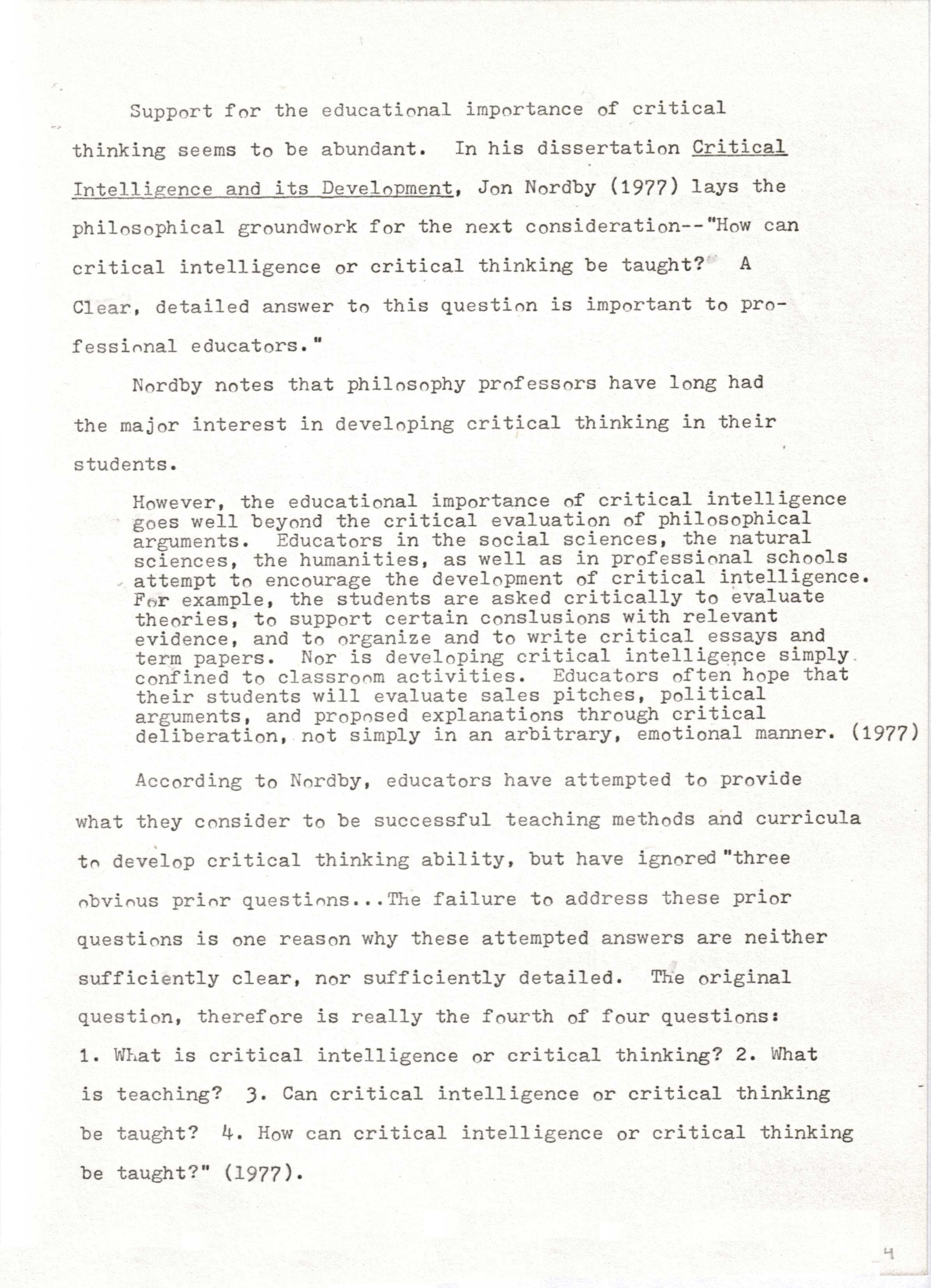
ctomeegmiu04.jpg
|
Support for the educational
importance of critical thinking seems to be abundant. In his dissertation
Critical Intelligence and its Development, Jon Nordby (1977) lays the
philosophical groundwork for the next consideration--"How can critical
intelligence or critical thinking be taught? A clear, detailed answer to
this question is important to professional educators."
Nordby notes that philosophy
professors have long had the major interest in developing critical thinking in
their students.
-
However, the educational
importance of critical intelligence goes well beyond the critical evaluation
of philosophical arguments. Educators in the social sciences, the
natural sciences, the humanities, as well as in professional schools attempt
to encourage the development of critical intelligence. For example, the
students are asked critically to evaluate theories, to support certain
conclusions with relevant evidence, and to organize and to write critical
essays and term papers. Nor is developing critical intelligence simply
confined to classroom activities. Educators often hope that their
students will evaluate sales pitches, political arguments, and proposed
explanations through critical deliberation, not simply in an arbitrary,
emotional manner. (1977)
According to Nordby, educators
have attempted to provide what they consider to be successful teaching methods
and curricula to develop critical thinking ability, but have ignored "three
obvious prior questions... The failure to address these prior questions is one
reason why these attempted answers are neither sufficiently clear, nor
sufficiently detailed. The original question, therefore is really the
fourth of four questions:
1. What is critical intelligence or critical thinking?
2. What is teaching?
3. Can critical intelligence or critical thinking be taught?
4. How can critical intelligence or critical thinking be taught?" (1977).
|
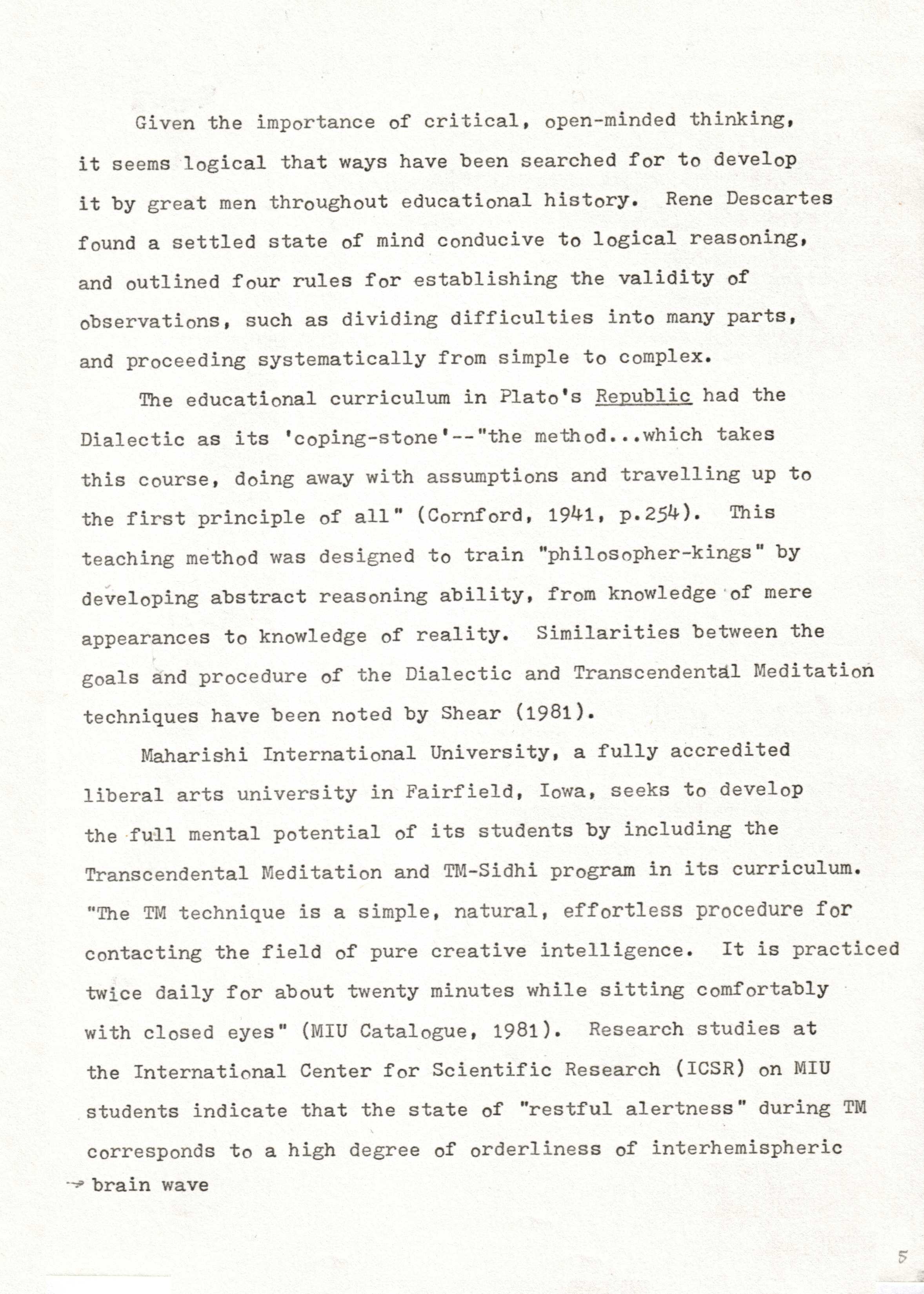
ctomeegmiu05.jpg
|
Given the importance of
critical, open-minded thinking, it seems logical that ways have been searched
for to develop it by great men throughout educational history. Rene
Descartes found a settled state of mind conducive to logical reasoning, and
outlined four rules for establishing the validity of observations, such as
dividing difficulties into many parts, and proceeding systematically from simple
to complex.
The educational curriculum in
Plato's Republic had the Dialectic as its 'coping-stone' -- "the
method...which takes this course, doing away with assumptions and traveling up
to the first principle of all" (Cornford, 1941, p.254). This teaching
method was designed to train "philosopher-kings" by developing abstract
reasoning ability, from knowledge of mere appearances to knowledge of reality.
Similarities between the goals and procedure of the Dialectic and Transcendental
Meditation techniques have been noted by Shear (1981).
Maharishi International
University, a fully accredited liberal arts university in Fairfield, Iowa, seeks
to develop the full potential of its students by including the Transcendental
Meditation and TM-Sidhis program in its curriculum. "The TM technique is a
simple, natural, effortless procedur efor contacting the field of pure creative
intelligence. It is practiced twice daily for about twenty minutes while
sitting comfortably with closed eyes" (MIU Catalogue, 1981). Research
studies at the International Center for Scientific Research (ICSR) on MIU
students indicate that the state of "restful alertness" during TM corresponds to
a high degree of orderliness of interhemispheric brain wave
|
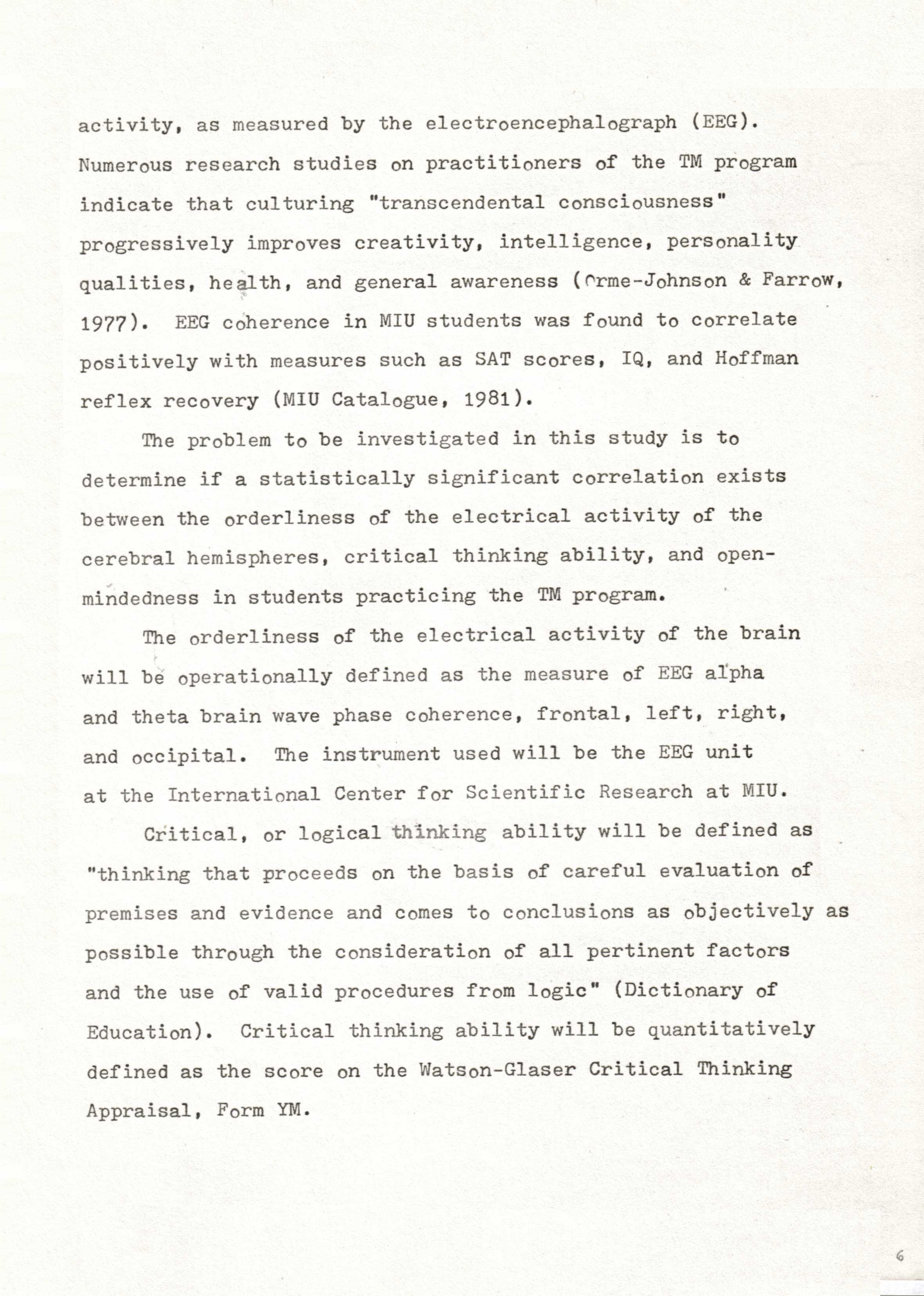
ctomeegmiu06.jpg
|
activity, as measure by the electroencephalograph
(EEG). Numerous research studies on practitioners of the TM program
indicate that culturing "transcendental consciousness" progressively improves
creativity, intelligence, personality qualities, health, and general awareness (Orme-Johnson
& Farrow, 1977). EEG coherence in MIU students was found to correlate
positively with measures such as SAT scores, IQ, and Hoffman reflex recovery (MIU
Catalogue, 1981).
The problem to be investigated in
this study is to determine if a statistically significant correlation exists
between orderliness of the electrical activity of the cerebral hemispheres,
critical thinking ability, and open-mindedness in students practicing the TM
program.
The orderliness of the electrical
activity of the brain will be operationally defined as the measure of EEG alpha
and theta brain wave phase coherence, frontal, left, right, and occipital.
The instrument used will be the EEG unit a the International Center for
Scientific Research at MIU.
Critical, or logical thinking
ability will be defined as "thinking that proceeds on the basis of careful
evaluation of premises and evidence, and comes to conclusions as objectively as
possible through the consideration of all pertinent factors and the use of valid
procedures from logic" (Dictionary of Education). Critical thinking will
be quantitatively defined as the score on the Watson-Glaser Critical Thinking
Appraisal, Form YM.
|
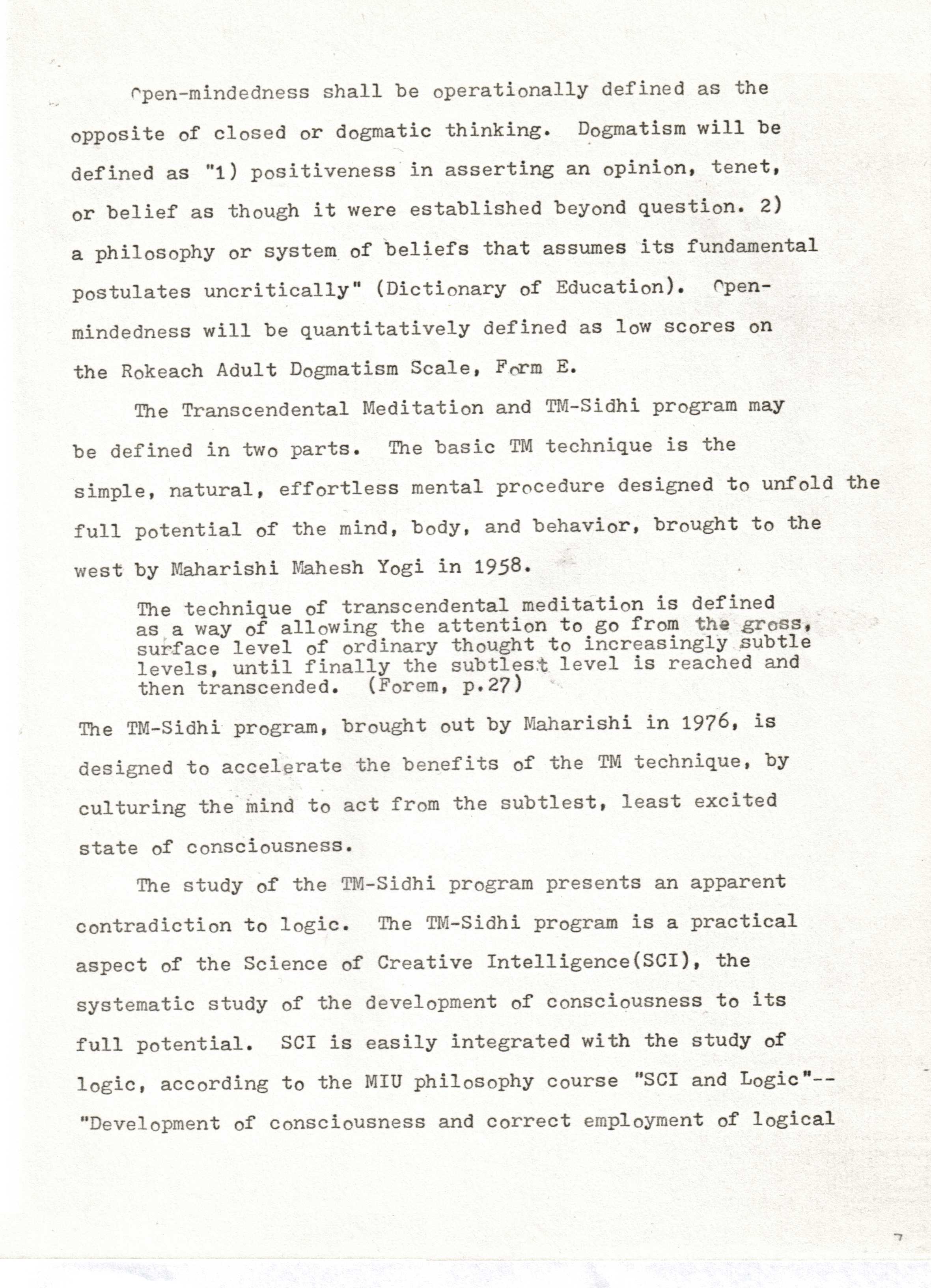
ctomeegmiu07.jpg
|
Open-mindedness shall be operationally defined as the
opposite of closed or dogmatic thinking. Dogmatism will be
defined as "1) positiveness in asserting an opinion, tenet,
or belief as though it were established beyond question. 2)
a philosophy or system of beliefs that assumes its fundamental
postulates uncritica1ly” (Dictionary of Education). Open-mindedness will be quantitatively defined as low scores on
the Rokeach Adult Dogmatism Scale, Form E.
The Transcendental Meditation and TM—Sidhi program may
be defined in two parts. The basic TM technique is the
simple, natural, effortless mental procedure designed to unfold the
full potential of the mind, body, and behavior, brought to the
west by Maharishi Mahesh Yogi in 1958.
- The technique of transcendental meditation is defined
as a way of allowing the attention to go from the gross,
surface level of ordinary thought to increasingly subtle
levels, until finally the subtlest level is reached and
then transcended. (Forem, p.27)
The TM-Sidhi program, brought out by Maharishi in 1976, is
designed to accelerate the benefits of the TM technique, by
culturing the mind to act from the subtlest, least excited
state of consciousness.
The study of the TM—Sidhi program presents an apparent
contradiction to logic. The TM-Sidhi program is a practical
aspect of the Science of Creative Intelligence (SCI), the
systematic study of the development of consciousness to its
full potential. SCI is easily integrated with the study of
logic, according to the MIU philosophy course "SCI and Logic' --
"Development of consciousness and correct employment of logical
|